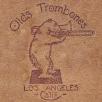
It's a bear!
Late 1920's "Symphony Model" Standard
Bore: .530"-.554" (13.5 mm-14.1 mm)
Bell: 8" (203.2 mm)
and
Late 1920's "Sympony Model" Standard with F-attachment (bell only)
Bore: attachment .565" (14.4 mm)
Bell: 8¼” (209.6 mm)
From the ©1927 Olds catalog:
The Symphony model was the largest trombone listed in Olds' catalog. To place these instruments in the proper historical context, it must be pointed out that they were made duing a time when orchestral trombone sections were in transition. An "American" style of symphonic trombone (and trombone playing) was evolving, incorporating elements of the French and German styles that had previously been the norm. Instrument such as the Conn 8H "Large Symphony" and the Keefer "Gardell Simons" appeared in the 'teens and early twenties; horns in or near what was then considered the "bass trombone" size range, but intended for use as tenors. Although the "symphonic tenor" eventually went on to almost universal acceptance, the Olds version appears to have fallen by the wayside. Few examples exist, and there is no mention of a Symphony model in the 1930's catalogs. The largest size tenor trombone specifically referenced is the L-8, though it is mentioed that "Other sizes from 6-inch solo bells to bass trombones with with F valve, made to special order." It wasn't until the introduction of the Opera model in the mid-1950's that Olds would again actively market a symphonic tenor trombone.
Symphony Model
I obtained this horn from Benn Hansson, a Seattle, WA area bass trombonist and repair technician. This particular instrument has very large throat bell and takes a small-shank mouthpiece. It's gold plated (except the upper outer slide tube - more on that below); what Olds called Finish 3; "Quadruple satin finish gold plate, on full weight silver plate. Elaborately engraved by hand." In 1927, a Finish 3 horn listed for $200 - twice the cost of a horn in the basic Finish 1. It was in very good condition with the exception of the upper outer tube, which, due a misadventure while cleaning/polishing the inside diameter, had a significant crack (the cleaning rod was still jammed in the tube, as well). By an amazing stroke of good luck, John Sandhagen just happened to have a partial vintage Olds slide with a lower outer that was a perfect match.
 Overall View |
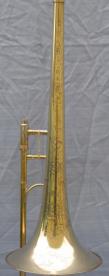 Bell Engraving |
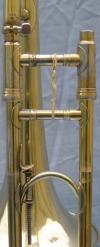 Braces |
 Bell Marking |
 The Bear |
 End Crook |
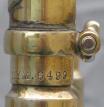 Slide Marking |
Symphony Model with F-attachment (bell section only)
This bell is a bit older than the horn above (the serial number is in the low 6000's). It's more utilitarian than its cousin, above - Finish 1 rather than Finish 3, with only the standard Olds engraving of the era - but is otherwise identical except for the addition of an f-attachment. It's the f-attachment that makes things interesting.
This isn't the earliest f-attachment Olds I've seen; it is, however, it shows a definite evolution of design when compared to earlier examples. Most noticeable is the f-attachment wrap, which is much closer in layout to the standard Olds "flat wrap" seen on later models such as the S-20 bass and R-20 Recording. Earlier f-attachment Olds trombones (such as the circa 1920 horn in my collection) also used a flat wrap, but the layout was not the same..
This is also the earliest example I've seen of the trademark "internal spring" Olds rotor valve. Earlier horns used an external spring valve that was most likely sourced from a European manufacturer (possibly Cerveny). It's reasonable to think that manufacturing valves in-house would not have been economical for Olds when they were only needed for the occasional f-attachment trombone, but that equation would have changed when trumpets and cornets were added to the line in the late 1920's. Many (through certainly not all) of the same processes that go into making a piston valve set would have also been applicable to making a rotor valve. Also of note is the presence of the company name engraved into the valve casing; similar markings can be found on early Olds trumpets (such as #331, shown here on Robb Stewart's website).
I don't usually comment on the playability of a particular instrument, but I should mention that, when this bell is mated with the slide of the straight tenor shown above, the ergonomics of the resulting combination are very poor. There simply is not enough clearance between the neck of the player and the valve. This leads me to suspect that the correct slide for this bell might have been wider than the one I was using.
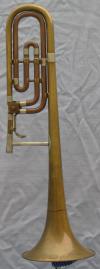 Overall View Front |
 Overall View Back |
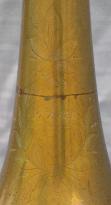 Bell Engraving |
 Valve Engraving |
 The Bear |
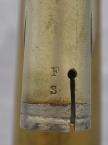 Receiver Marking |